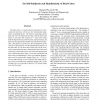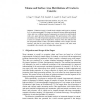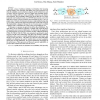20 search results - page 4 / 4 » Some Properties of Swapped Interconnection Networks |
IPPS
2003
IEEE
14 years 3 months ago
2003
IEEE
The dual-cube is a newly proposed topology for interconnection networks, which uses low dimensional hypercubes as building blocks. The primary advantages of the dual-cube over the...
COMPGEOM
2001
ACM
14 years 1 months ago
2001
ACM
We propose a new randomized algorithm for maintaining a set of clusters among moving nodes in the plane. Given a specified cluster radius, our algorithm selects and maintains a va...
IWVF
2001
Springer
14 years 2 months ago
2001
Springer
Volumetric images of small mortar samples under load are acquired by X-ray microtomography. The images are binarized at many different threshold values, and over a million connecte...
CISIS
2008
IEEE
13 years 11 months ago
2008
IEEE
Bluetooth standard allows the creation of piconets, with one node serving as its master and up to seven nodes serving as slaves. A Bluetooth ad hoc network can also be formed by in...
INFOCOM
2002
IEEE
14 years 2 months ago
2002
IEEE
— Recently, a class of solutions including Core-Stateless Fair Queueing (CSFQ), Rainbow Fair Queueing, and Diffserv have been proposed to address the scalability concerns that ha...



